|
Logic Instrument FieldBook Tablet PC
A rugged compact handheld tablet computer
(by Conrad H. Blickenstorfer, with photography by Carol Cotton -- view PDF version)
In a phenomenon that caught the computer industry by surprise, consumers have been buying tens of millions of "netbooks." They did that because netbooks are smaller, lighter, handier and less expensive than full-size notebooks. We're starting to see a similar trend in the mobile rugged computing industry with the introduction of smaller, lighter and handier tablet computers that weigh three pounds or less, yet provide performance that's more than adequate for many jobs. In this article we're taking a detailed look at the Logic Instrument FieldBook.
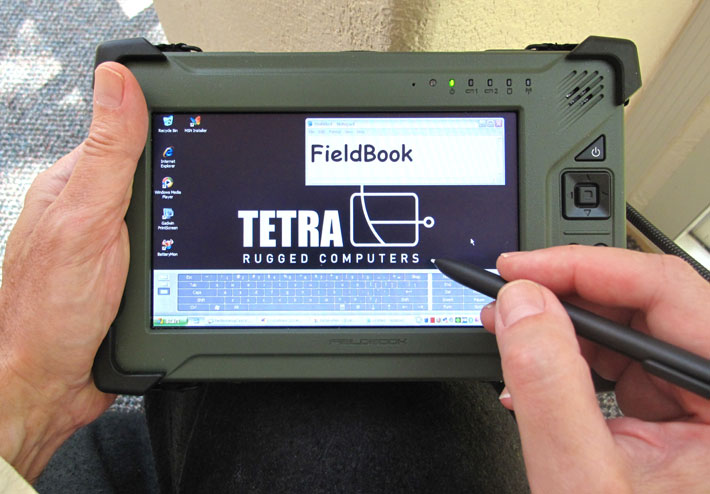
In essence, the FieldBook is significantly smaller version of a conventional full-size tablet computer. It weighs three pounds instead of five or six, it has a footprint smaller than that of most netbooks, it's silent because it doesn't need a fan, and it's powered by a super-efficient Intel Atom processor. It's also configurable and customizable to the max. Below you can see what markets Logic Instrument has in mind for this machine.
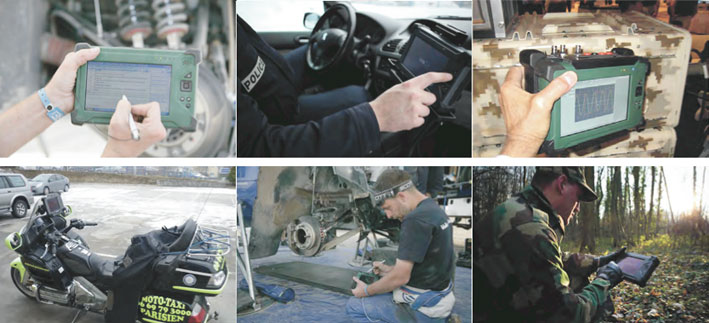
The smaller size and lower weight comes at a price. The display measures just 7 inches diagonally instead of the 8.4 or ten inches of larger tablet computers. That's also a good bit smaller even than the small displays of consumer netbooks that now have mostly moved up to 10-inch screens. On the other hand, the display uses the "modern" 16:10 wide-format aspect ratio, and its 1024 x 600 WSVGA pixel resolution is what's considered acceptable in all those millions of netbooks, and it's actually more than 800 x 600 pixel SVGA format still used on many full-size tablet computers. The FieldBook is designed to be rugged enough to handle almost any job out there, and it's so configurable that it's suitable for any number of data capture jobs that require flexible communication and I/O solutions.
Where does the FieldBook fit in?
The application pictures shown above show the intended use of the FieldBook, but they don't convey how small and handy the device actually is. Over the years there have been many efforts to make "full Windows" (as opposed to the much more limited Windows CE or Windows Mobile) available in smaller form factors. This often resulted in devices that offered impressive technology, but were simply too small to be used productively. Does the FieldBook avoid those problems and truly offer the functionality of a full-size Windows tablet?
For the most part yes, because while the FieldBook is small and handy, it isn't really tiny. The display is large enough, and the system uses standard ports and functionality, so there is no need for a lot of adapter cables and such. The composite picture below shows the computer from the front and from all four sides:
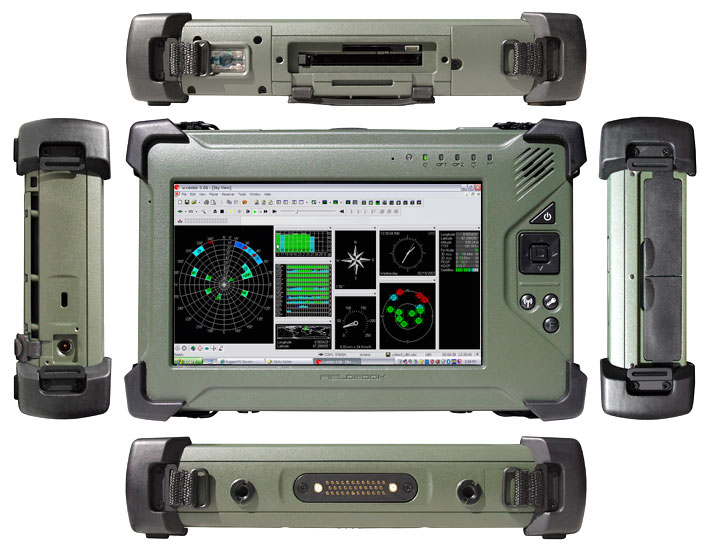
What you get, in essence, is a complete tablet computer running Windows XP or Vista (with Windows 7 and Linux support in the works). There are externally accessible card slots and standard ports, and you can equip the device with a scanner, RFID reader, GPS and various types of wireless communication. As you can see in the picture above, our review unit had a full PC Card slot with a SD card slot above it (the PC Card slot can be replaced by either a mini-PCIe slot and a SIM card slot or an ExpressCard 34/54 slot, and Logic Instrument can also provide CANbus support). To the left of it is the 1D/2D scanner. To the right is the cover underneath which is the optional GPS receiver.
On the bottom is a sealed surface-mount 35-pin docking connector flanked by two threaded inserts that allow sealed mounting of custom expansion boxes or special docks, and also the standard office dock.
On the right, you can see two rubber flap covers that seal the customizable I/O plate that can accommodate five different I/O port arrangements (description in next section).
Design and construction
The inherent ruggedness of the platform stems from its beefy structural design. This is not a box filled with components, but a very sturdy magnesium alloy chassis with individual compartments for components. This makes the chassis rigid and totally immune to flex or twisting.
 The picture to the right shows the backside of the FieldBook. To the left is a cover with a small cover inside of it. To the right the two batteries that fit flush into the backside. In the top center, above the left battery you can see the lens of the integrated 2-megapixel digital camera. The picture to the right shows the backside of the FieldBook. To the left is a cover with a small cover inside of it. To the right the two batteries that fit flush into the backside. In the top center, above the left battery you can see the lens of the integrated 2-megapixel digital camera.
When unscrewing the lefthandside cover, I expected to find a battery expansion or a mini-PCI slot for wireless expansion underneath. Instead, once you remove the six small Philips screws that hold the small door in place, you see an embossed label that says "Thermal Door" in the larger cover which also has a hole to the inside of the computer that's sealed with a rubber plug. Nine additional small Philips screws hold the larger cover in place. Between the larger cover and the housing is a O-ring-style rubber gasket. Underneath the double doors are a heat sink assembly (probably for the processor and chipset) and the computer's main I/O module. The I/O module approach allows Logic Instrument to equip the FieldBook with your choice of no fewer than four different I/O configurations. They are:

- 2 USB 2.0 + 1 RS232
- 2 USB 2.0 + 1 RJ45 + 2 audio jacks
- 1 USB 2.0 + 1 RS232 + 1 RJ45
- 2 RS232
This is an interesting solution, and one that makes it very easy to change I/O configurations practically on the fly. 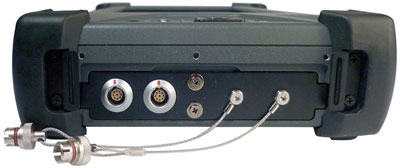 Being able to equip the FieldBook with exactly the right complement of ports for any given job is definitely an advantage. It'd be nice to have all those ports available at all time, but that's simply not possible in small mobile devices. And keep in mind the optional desktop and vehicle cradles both provide four additional USB ports, a serial port, analog VGA port, serial as well as a GPS antenna port. About the only criticism I have about that arrangement is that the I/O boards should really provide their own sealing, and not completely rely on the outer rubber plugs. Being able to equip the FieldBook with exactly the right complement of ports for any given job is definitely an advantage. It'd be nice to have all those ports available at all time, but that's simply not possible in small mobile devices. And keep in mind the optional desktop and vehicle cradles both provide four additional USB ports, a serial port, analog VGA port, serial as well as a GPS antenna port. About the only criticism I have about that arrangement is that the I/O boards should really provide their own sealing, and not completely rely on the outer rubber plugs.
In addition to the four configurations above, there is an option with two waterproof circular RS232 connectors (see picture above), or the entire I/O area can be sealed off completely. And if a system is only used with wireless communication, Logic Instrument offers a sealed ports option that cannot be removed in the field and allows a customer to eliminate the possibility for their users to access I/O.
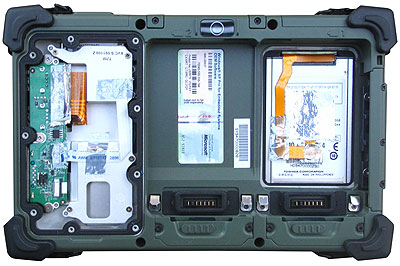 The picture to the right shows the unit with the doors and batteries removed. You can now see the heatsink assembly that's designed to leave room for the unit's optional Intermec barcode scanner (installed in our review unit). The picture to the right shows the unit with the doors and batteries removed. You can now see the heatsink assembly that's designed to leave room for the unit's optional Intermec barcode scanner (installed in our review unit).
The FieldBook can accommodate either standard 1.8-inch hard disks or solid state disks. The hard disk compartment sits underneath one of the batteries, but has its own sealing via a metal cover and a rubber pressure seal. Our review unit came with a 120GB Toshiba MK1235GSL ultra-low-power hard disk that is inherently resistant to shock and can handle bumps up to 500G while operating. In addition, the disk is mounted in a shock-absorbing rubber subframe, adding further protection. The disk includes a G sensor and our unit came with the optional spindle heater (see image). As with all O-ring or pressure seals, always make certain there is no debris on the seal and that the rubber is not caught or folded somewhere before you lock things down.
Note that the housings for the two batteries are custom-designed to be part of the unit. They fit flush into the backside. The battery modules fit tightly, but do not have seals themselves. Instead, a small, replaceable rubber O-ring assembly around the battery connector makes sure no water gets into the interior electronics of the computer. This dual battery solution allows users to hot-swap batteries without shutting down the computer as power will be provided by the second battery. The batteries are firmly held in place by friction sliders; there are no tools necessary to replace the batteries.
An interesting footnote about the FieldBook's power supply: the unit is approved for use with the JENNY 600S fuel cell by Smart Fuel Cell AG. The fuel cell powers the FieldBook for about 20 hours on a single methanol fuel cartridge.
The front bezel is made of tough plastic though its finish is almost indistinguishable from the metal exterior parts of the machine. Extra protection is provided by nicely and cleverly designed replaceable rubber bumpers that are firmly fastened onto every corner via four small Philips screws. Small metal plates on each side of each bumper serve both as strap attachments and as washers to secure the screws. All ports are protected by soft, hinged and replaceable rubber plugs. Always put them firmly in place as they are the primary barriers between the outside and inside of the FieldBook.
Ruggedness
All of Logic Instrument's systems are rugged and the FieldBook is no exception. It is a compact and very solid machine that, even before you look at the ruggedness test result, feels like it can stand up to hard use and abuse. When you do get to the specs, they are impressive. The FieldBook carries an IP54 ingress protection where the "5" means the unit is protected against dust to the extent where there will be no harmful deposits, and the "4" means the machine is protected against water spray from all directions, though limited ingress is permitted. The standard operating temperature range is 32 to 131 degrees Fahrenheit (0 to 50C), with a special low temperature (-4 to 131F/-20 to 50C) option available for units that may be operated in freezing temperatures. The FieldBook also passed the MIL-STD 810G Method 516.6 Procedure VI "Drop" test that included 26 drops to concrete on each face, edge and corner from 48 inches, or 1,2 meters for the metrically inclined. That's about what we expected.
Powered by Intel Atom
The FieldBook is powered by an Intel Atom processor. The Atom platform was introduced by Intel a couple of years ago as a solution for devices that did not need the performance of one of Intel's Core processors or needed a processor solution that generated less heat and consumed less power. Intel delivered and Atom processors have been hugely successful for the company, with many millions of netbooks, and a rapidly growing number of vertical market devices, using Atom processors. Let's take a look at Atom's background?
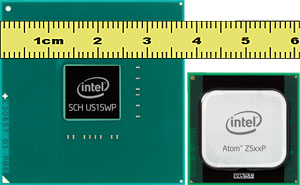 In order to fend off growing criticism over its mobile processor offerings, Intel's goals for the Atom processors were low power consumption and low cost while still delivering adequate (or, as is often used, "targeted") performance. As a result, the Atom platform was an entirely new design that allowed Atom chips to require much less power than the slowed down ultra-low voltage versions of Intel's Core processors. There is a bit of a trade-off, of course. To preserve power and keep costs down, most Atom chips only have one core. They do, however, use HyperThreading, an older Intel technique that uses two threads while increasing power consumption by only about 10%. In order to fend off growing criticism over its mobile processor offerings, Intel's goals for the Atom processors were low power consumption and low cost while still delivering adequate (or, as is often used, "targeted") performance. As a result, the Atom platform was an entirely new design that allowed Atom chips to require much less power than the slowed down ultra-low voltage versions of Intel's Core processors. There is a bit of a trade-off, of course. To preserve power and keep costs down, most Atom chips only have one core. They do, however, use HyperThreading, an older Intel technique that uses two threads while increasing power consumption by only about 10%.
As far as architecture goes, Atom chips are fairly simple but include a variety of power conservation features in the chip. A special bus mode minimizes power needed to transmit data to the processor. Cache is flushing cache data to system memory during periods of inactivity. Intel power conservation modes were improved and a new standby mode can essentially shut down the processor. All of these measures can result in dramatically reduced overall power consumption while still providing acceptable performance.
The Z530P processor used in the FieldBook is part of the initial Z5xx family of Atom processors that was codenamed "Silverthorne" (see Intel brochure on the Z5xx). The "P" signifies that the chip uses the "large footprint" version with a 22 x 22 mm package size (as opposed to the tiny 13 x 14 mm package footprint for the original version) that can handle industrial temperature ranges. Intel targeted the Silverthorne chips at mobile internet devices (MIDs), but they have also become quite common in rugged mobile and embedded devices. The Silverthorne processors use the "Poulsbo" System Controller Hub that was developed specifically for the Z5xx Series. The chipset—which supports PCI-E, SDIO, DDR2, LVDS, ATA 100, LPC and more—uses only about 2.3 watts, which means the total power consumption of the CPU and chipset combined isn't even 5 watts. That is only a small fraction of what a conventional Intel notebook processor and chipset uses. And the Poulsbo chipset even has hardware support for H.264 and other HD decoding (see Intel brochure on the "Poulsbo" US15W SCH).
Being such a fuel miser, how fast is the FieldBook? Based on our benchmark library of Atom Z530 systems, we expected the FieldBook to feel about as fast as a standard consumer netbook (which are actually based on a different family of Atom processors) and its relative performance compared to most full-size rugged tablets on the market to be at about the 60-65% level.
We used Passmark Software's PerformanceTest 6.1 that runs about 30 tests covering CPU, 2D graphics, 3D graphics, memory, and disk and then computes scores for each category and an overall PassMark score. For comparison, we're listing another machine available from Logic Instrument, the Getac E105M that uses a Intel A110 processor, as well as a system that uses a slower version of the Atom Z-series, and a standard netbook based on a different Atom chip that runs at the same clock frequency.
|
PERFORMANCE COMPARISON
|
Logic Instrument
|
Logic Instrument
|
Handheld
|
Acer
|
|
Model
|
FieldBook
|
Getac E105M
|
Algiz 8
|
Aspire 1
|
|
Processor
|
Intel Atom 530P
|
Intel A110
|
Intel Atom Z510
|
Intel Atom N270
|
|
CPU Speed
|
1.60 GHz
|
0.8 GHz
|
1.10GHz
|
1.60Hz
|
|
Thermal Design Power (TDP)
|
2.3 watts
|
3.0 watts
|
2.2 watts
|
2.5 watts
|
|
CPU Mark
|
235.5
|
207.2
|
107.8
|
239.1
|
|
2D Graphics Mark
|
84.6
|
119.8
|
92.3
|
144.4
|
|
Memory Mark
|
224.4
|
155.5
|
128.6
|
215.1
|
|
Disk Mark
|
266.4
|
200.2
|
245.7
|
375.8
|
|
3D Graphics Mark
|
9.8
|
63.1
|
14.5
|
81.7
|
|
Overall PassMark
|
170.3
|
148.3
|
116.1
|
208.4
|
What do these figures show? Primarily, to be honest, that benchmarks can yield really strange results when comparing different processor architectures. However, after having conducted many hundreds of benchmarks in the RuggedPCReview.com lab, we found that the bottomline is usually a good indication of a system's actual overall performance. So what we can see here is that the FieldBook is clearly faster than products based on Intel's last generation low-power processor (the A110) and significantly faster than machines based on the lower end Atoms. In line with other benchmark testing, we also found again that at the same clock speed, "Silverthorne" base systems benchmark a bit less than Atom "Diamondville" systems.
In real live usage, the FieldBook feels quick and responsive, and certainly up to the job. However, it's still powered by an Atom processor, so anyone with significant performance requirements should make sure that an Atom-based system can handle target applications.
Storage
Our FieldBook review unit came with a 4,200rpm 120GB Toshiba MK1235GSL hard disk. This is a 1.8-inch design with a SATA interface that's generally used in space-constrained applications. The disk assembly weighs just over three ounces and uses very little power (around one watt while reading or writing, about 0.4 watt while idle). It operates silently. The FieldBook can also be ordered with a Solid State Disk (SSD) storage with 16, 32 or 64GB capacity.
G-Sensor
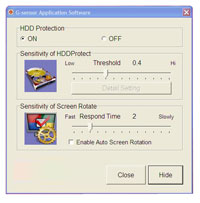 The FieldBook has an integrated acceleration sensor that is used for two different purposes. The FieldBook has an integrated acceleration sensor that is used for two different purposes.
First, the sensor provides hard disk protection, presumably by instantly moving the read and write head of the disk into a safe zone when excessive acceleration is detected. A special G sensor control panel (see image to the right) lets you turn G sensor HD protection on and off, and also lets you select activation threshold of the protection.
Second, the FieldBook uses the G sensor to manage automatic screen rotation. The sensor knows why side is up and will always rotate the display into the proper position, be that landscape or portrait. Automatic screen rotation can be enabled or disabled, and you can set how quickly it reacts. I found a slow setting preferable as there aren't many occasions where you want to quickly toggle between landscape and portrait. Screen reorientation takes about four seconds.
Wireless communication
Like most modern mobile computing devices, the FieldBook includes WiFi functionality and can also be equipped with a variety of other wireless options. The devices comes standard with an Intel WiFi Link 5100 Series wireless network adapter (view Intel PDF brochure on the 5100 Series). It is a small and compact PCIe mini card that supports both the legacy 802.11a/b/g wireless protocols as well as the new N standard protocol with its much faster receive data rates of up to 300Mbps (802.11a/b/g is only good for up to 54Mbps). In addition to the potential 5X bandwidth and 2X range increase over older protocols, the WiFi Link 5100 is power-efficient, supports Cisco compatible extensions v4, and supports a number of Intel proprietary technologies such as PROSet and Intel My WiFi.
Integrated Bluetooth Class 1 version 2.1 with EDR (Enhanced Data Rate; theoretically up to 3 megabits per second) is optional, as is 3G wireless through a Sierra Wireless mini-PCIe card that takes the place where the PC Card slot is. Note that 3G installations also have an externally accessible SIM card slot next to the WWAN module.
For data capture applications that require RFID, the FieldBook can be equipped with a 13.56MHz Microprogram RFID scanner. RFID tag compatibility includes Mifare One S50 and S70, Ultra Light, SR176, Srix4K, ICODE SLI, Tag-It HF-I, and full Mifare functionality (see Mifare.net).
Bright 7-inch display
Since the FieldBook will be used indoors as well as outdoors, its 7-inch display can handle a wide variety of operating conditions. It's considered sunlight readable, and that is accomplished by a combination of a fairly strong LED backlight (up to 320 nits, adjusted via ambient light sensor) and optical treatment with polarizers and filters. As a result, the FieldBook's display is bright enough to be legible outdoors when turned away from the sun, and it also remains readable in direct sunlight. The unretouched picture below shows the FieldBook outdoors in bright daylight.
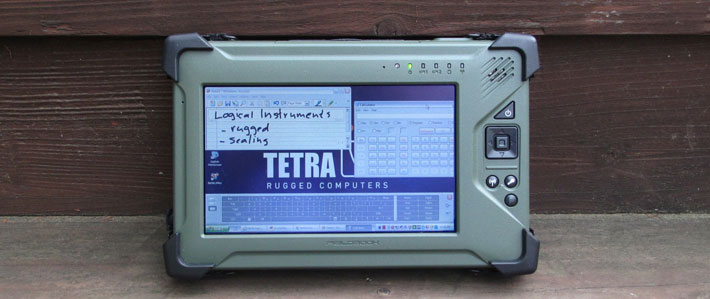
Display brightness and contrast are not the only things that matter when it comes to outdoor viewability. Glare, reflections, and inadequate viewing angles are all important and can be the difference between a machine that is truly usable outdoors, and one that is not. The pictures below show that the FieldBook has very good glare and reflection control and that the horizontal viewing angle is good enough for most applications. The vertical viewing angle is somewhat narrow, but with a tablet that is usually not as much of an issue as with a notebook.
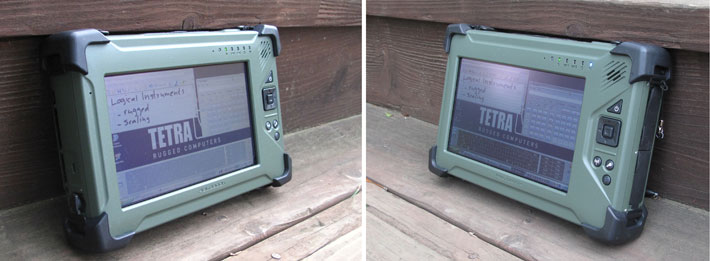
As far as the computer's display size and resolution go, while seven inches diagonal is a small display, the 1024 x 600 display resolution is the same as that on many millions of netbook computers. The small display size means there are over 170 pixels per inch, making for a picture that is significantly sharper and crisper than what you get on a standard notebook. Unfortunately, of course, Windows wasn't really designed for a screen this small, and so the tiny fonts, icons and controls take some getting used to, as is the 1024 x 600 format where content formatted for at least 1024 x 768 XGA resolution often gets cut off at the bottom. I should mention that there is an interpolated 1024 x 768 mode that could come in handy for application software that is preformatted for XGA or other times when full XGA seems preferable despite the interpolation distortion.
"Stealth Mode" operation
The FieldBook also has a "stealth mode" function to allow you to operate the computer without any lights or other emissions to give away its presence. This is managed through a section in the BIOS setup utility. In stealth mode, the FieldBook will boot up with all of its indicator lights off, speaker off, whatever wireless radio modules are installed off, and screen brightness set to a barely perceptible five nits. Stealth mode simply means the computer boots up this way; when in operation, all those functions can be activated.
Digitizer
While touch and multi-touch are all the rage these days, the FieldBook comes with a more conventional 4-wire resistive touchscreen. That means, yes, it reacts to finger touch, but it's really primarily supposed to be used with a stylus. And no, it's not an active digitizer, the kind where the cursor follows the tip of the pen as you hover it in close proximity above the display. To be honest, I'd like to see at least an active digitizer option as the tablet functionality in Windows is geared more towards active pens than touch.
Configuration of the touch screen is via the PenMount control panel that lets you configure multiple monitors and also gestures. There are also three config screens that handle calibration using 4, 9, 16, or 25 points, with 25 points offering maximum accuracy. A "Draw" mode provides digitizer statistics and can be used for debugging. An option menu lets you set the operation mode either to stream mode or point mode.
In the panel's Settings menu you can also enable a beep sound to occur on pen down or pen up (or both), and even set its frequency and duration. This may sound strange, but in noisy vehicle operation, having auditory feedback to confirm a touch operation may come in handy. There's also a cursor stabilizer option as well as how to handle right clicks and such. Another panel handles edge compensation that can improve cursor accuracy along the perimeter of the display.
Below you can see three of the PenMount control panel screens.

As is, the FieldBook digitizer works well, and there are enough settings and configuration options to personalize it or adapt it to a specific application. It still would be nice to have an active digitizer option, or, better yet, a dual input panel option that supports both active pen and touch.
For barcode scanning applications: integrated 1D/2D scanner/imager
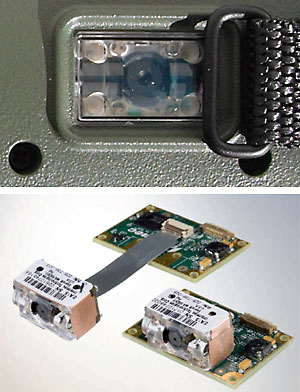 Our review FieldBook came with the optional barcode scanner installed. It's a super-compact 2-D imager engine made by Intermec. Mounted into the top side of the device, there is an Intermec EA15 scanner module, visible underneath a protective cover with a clear plastic window. The EA15 scan engine can read both conventional 1D barcodes and the more complex 2D barcodes, thus providing maximum flexibility. Based on solid-state CMOS technology, the module was designed for optimal image sensitivity and dynamic range, and for reliable performance even under sub-optimal conditions, and from anywhere between total darkness to bright sunshine. It also has good tolerance to motion, meaning you don't have to hold it completely still to get a good scan, and it is very quick (about twice as fast as a traditional 2D imager engines). With linear codes, the EA15 engines can do as many as 200 scans per second, aided by an aiming system that emulates the way 1D barcode scanners work. You can (see http://www.intermec.com/products/scanea15/index.aspx). Our review FieldBook came with the optional barcode scanner installed. It's a super-compact 2-D imager engine made by Intermec. Mounted into the top side of the device, there is an Intermec EA15 scanner module, visible underneath a protective cover with a clear plastic window. The EA15 scan engine can read both conventional 1D barcodes and the more complex 2D barcodes, thus providing maximum flexibility. Based on solid-state CMOS technology, the module was designed for optimal image sensitivity and dynamic range, and for reliable performance even under sub-optimal conditions, and from anywhere between total darkness to bright sunshine. It also has good tolerance to motion, meaning you don't have to hold it completely still to get a good scan, and it is very quick (about twice as fast as a traditional 2D imager engines). With linear codes, the EA15 engines can do as many as 200 scans per second, aided by an aiming system that emulates the way 1D barcode scanners work. You can (see http://www.intermec.com/products/scanea15/index.aspx).
From a technical standpoint, the EA15 is capable of decoding bar code information down to one pixel per dot, which means it is equipped to handle even damaged or poorly printed codes. Currently supported codes are the EAN/UPC, RSS, Code 39, Code 128, UCC/EAN 128, ISBN, ISBT, Interleaved, Matrix, Industrial and Standard 2 of 5, Codabar, Code 93/93i, Code 11, MSI, Plessey, Telepen, and postal codes 1D symbologies, as well as Data Matrix, PDF417, Micro PDF 417, Maxicode, QR, Aztec, and EAN.UCC composite 2D symbologies.
In terms of resolution, the EA15 module records at 752 x 480 pixels with 256 levels of gray. For tech information on the Intermec EA15 2-D imager engine, check here. Note that a scan engine SDK is available for custom applications, and that the scan engine uses one of the system's serial interface ports.
Mounting solutions
Since a device like the FieldBook may be used in vehicles as well as various other locations, Logic Instrument offers a variety of docks and mounting solutions. The picture below shows three different solutions.
The standard dock (left) that provides locking, additional I/O and the full flexibility of the RAM Mounts system that can be used to install the system virtually anywhere.
The rugged dock (center) is designed for environmentally demanding situations that require quick locking and unlocking of the device. Like the standard dock, the rugged dock provides additional I/O.
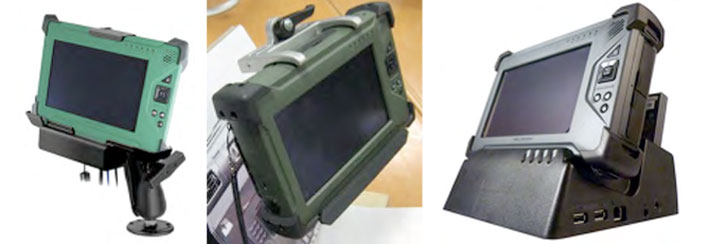
The office dock (right) provides I/O as well as charging stations for two additional batteries. This dock is also equipped with an MCX connector for an external GPS antenna.
Numeric keypad and other data entry methods
As a classic tablet computer, the FieldBook only has a minimum of external physical controls. Shown below, the controls include an on/off switch, a five-way PDA-style navigation pad, a security button that, in essence, issues a Windows Alt-Ctl-Del, a wireless radio on/off button, and a function key. In conjunction with the function key, the navigation pad's directional keys also serve to adjust volume and brightness. This is not marked, and thus not obvious. Logic Instrument also plans to offer button settings and programming as part of an upcoming "dashboard" utility.

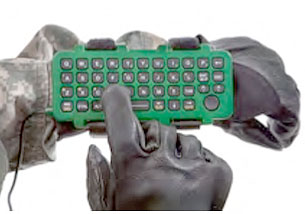 For the most part, tablet computers in vertical market applications are used with custom applications optimized for touch or pen input.
For the most part, tablet computers in vertical market applications are used with custom applications optimized for touch or pen input.
There is Microsoft's input panel that includes a comprehensive onscreen QWERTY keyboard. That keyboard, however, requires the stylus; it does not work with touch (unless you consider tapping with a fingernail touch). With the iPhone, Apple has shown what the combination of a capacitive touchscreen and a good onscreen keyboard can do, and hopefully we'll soon see that functionality in devices such as the FieldBook.
When used with one of the optionally available docks, you can use a standard USB keyboard for data entry. An interesting option is an external wearable USB keyboard with a full QWERTY key layout shown on the right.
Handwriting recognition and other pen functionality
 Thanks to its touch screen, the FieldBook offers additional functionality that is not available on standard computers. That includes handwriting recognition, a fascinating technology that received a lot of bad press over the years, much of it based on unrealistic expectations. Thanks to its touch screen, the FieldBook offers additional functionality that is not available on standard computers. That includes handwriting recognition, a fascinating technology that received a lot of bad press over the years, much of it based on unrealistic expectations.
The Microsoft Input Panel offers extensive handwriting recognition entry.It requires some getting used to, but once mastered it works very well. The recognizer can be used as is, but you can also train it to learn your specific style of handwriting and how to recognize characters or words the recognition engine has trouble with. Anyone spending an hour or two learning how to use the handwriting recognition features offered in the FieldBook will be able to enter text quickly and accurately.
More pen functionality
 In order to take full advantage of a pen-based computer, you may want to install some of the freely available pen-centric utilities and applications. Microsoft offers a free "Experience Pack for Tablet PC" for download. In order to take full advantage of a pen-based computer, you may want to install some of the freely available pen-centric utilities and applications. Microsoft offers a free "Experience Pack for Tablet PC" for download.
The Experience Pack includes such useful utilities as the "Ink Desktop," which lets you take handwritten notes directly onto an always visible notepad. This comes in handy to quickly jot down notes, lists, phone numbers, instructions or whatever.
The ink pad also had templates such as grid paper, daily or monthly calendar, etc., and you can change ink color and thickness. There's also an eraser, you can make the pad transparent or just faded, and you can either use either just part or the full desktop for writing.
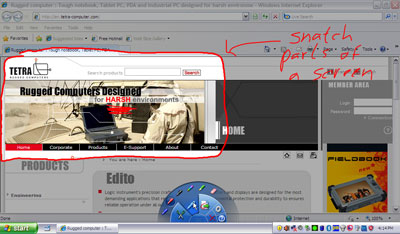 A utility that I find very handy and helpful is the "Snipping Tool." It allows you to use the stylus to select part of a website, document or any content by drawing a line around it or selecting a window. A utility that I find very handy and helpful is the "Snipping Tool." It allows you to use the stylus to select part of a website, document or any content by drawing a line around it or selecting a window.
You can then add handwritten comments if you wish, using different line thickness and color. There's also a highlighter that can be used to draw attention to whatever is important.
When you're done snipping and annotating, you can either save the snippet into a special snipping tool editor for further processing, you can print it, or you can even email it.
Snipping Tool is perhaps one of the most useful utilities on a device like the FieldBook, and I found myself using it all the time.
You can also use the FieldBook as an electronic notepad with Microsoft Journal. Depending on your style of work, Journal can be an immensely useful productivity tool. You can write down notes in electronic ink, create quick doodles and drawings, convert handwritten notes to text, email notes, and so on. There are different size and color pens, highlighters and also an eraser.
The above are just a few examples of useful tools available on pen-based systems. Lots are available, and they can add a lot of functionality that is simply not available in standard operating systems.
One caveat is that almost all of these tools were really designed for use with an active electronic digitizer where ink goes on smoother and there is additional pen functionality. I wish the FieldBook could be ordered with an active digitizer, at least as an option.
Bottom line
The FieldBook by Logic Instrument is a smaller and lighter version of a standard tablet computer. Measuring a compact 8.9 x 5.7 x 1.9 inches and weighing only about three pounds, the FieldBook is designed for applications where a full-size rugged tablet is too heavy and bulky. Despite its smaller size, the FieldBook hardly compromises: the 7-inch touch screen is small but offers full 1024 x 600 resolution, all I/O is via standard ports, and the device offers a wealth of optional integrated data collection and wireless functionality such as scanning, RFID, GPS and 3G radio.
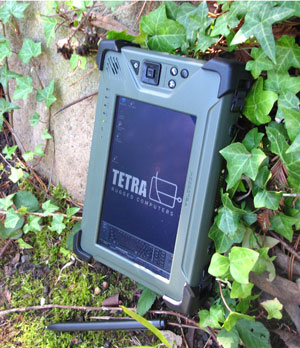 The FieldBook is based on the 1.6GHz Intel Atom Z530P processor that provides an optimal balance between low power consumption and adequate performance. The very low heat dissipation of the processor and chipset combination allows fanless, silent operation and impressive battery life from dual hot-swappable 19 watt-hour Li-Ion power packs. Even more powerful batteries are available for multi-shift operation. The FieldBook is based on the 1.6GHz Intel Atom Z530P processor that provides an optimal balance between low power consumption and adequate performance. The very low heat dissipation of the processor and chipset combination allows fanless, silent operation and impressive battery life from dual hot-swappable 19 watt-hour Li-Ion power packs. Even more powerful batteries are available for multi-shift operation.
The 7-inch display is bright and very sharp, and offers good outdoor viewability with very little glare. The resistive touch screen works well and is highly configurable, but we would like to see active and capacitive digitizer options.
For a device this small, the FieldBook has good onboard connectivity with a variety of USB/serial/LAN/audio I/O options, and plenty of additional connectivity via one of the optional docks. Onboard expansion is flexible as well, with PC Card, PCIe, SDHC, and SIM slots available, though not all at the same time. The FieldBook also has an integrated 2-megapixel camera for documentation.
The FieldBook's magnesium alloy chassis, sturdy construction, and additional rubber bumper protection make for a rugged device that can handle a lot of abuse in the field. The device is also well-sealed, though some of the sealing relies too much on soft rubber plugs.
With the FieldBook, Logic Instrument offers a supremely competent and hugely configurable mobile computing solution that addresses the need for a lighter, handier computer without giving up performance, compatibility or the versatile tablet form factor familiar to most mobile workers.
-- Conrad H. Blickenstorfer
FieldBook Specs:
| Type |
Compact rugged pen tablet
|
| Processor |
1.6GHz Intel Atom Z530P with 512KB L2 cache and 533MHz FSB |
| Display Chipset |
Intel "Poulsbo" System Controller Hub US15WP |
| Video |
Intel Graphics Media Accelerator 500 (Intel GMA 500) with 3D graphics (integrated in US15WP) |
| OS |
Windows XP Tablet PC Edition, Windows Vista, Windows 7 |
| Memory |
2GB DDR2 533MHz |
| Display |
7" sunlight readable WSVGA (1024 x 600 pixel) TFT with LED backlighting (max 320 nits) |
| Digitizer |
4-wire resistive touch screen |
| Keyboard |
Onscreen keyboard |
| Navigation |
5-way directional keypad |
| Storage |
120 GB shockmounted 1.8-inch 4200rpm SATA hard disk (Toshiba MK1235GSL) with G-sensor; optional 16/32/64GB solid state disk |
| Expansion slots |
1 SDHC Card + either 1 PC Card Type II slot OR 1 ExpressCard 34/54 OR 1 mini-PCIe + SIM; CANbus support available via PC Card, mini PCIe or dongle; also available: PCMCIA cable cover and other caps |
| Housing |
Lightweight magnesium alloy chassis, rubber bumpers |
| Size |
8.9" x 5.7" x 1.9" (225mm x 145mm x 48mm) inc. rubber bumpers |
| Weight |
3.0 pounds as tested (1,36kg) with dual battery, bumpers, scanner) |
| Operating temperature |
32 to 131 degrees Fahrenheit (0 to 55C); optional -4 to 131F (-20 to 55C) |
| Ingress protection |
IP54 (per ieC 60529 /aC2:2007; Rain chamber at no less than 40 PsiG and no less than 4 in/hr. 10 min per axis, 6 axes) |
| Drop/shock (with SSD) |
MIL-STD 810G, 506.6 VI: 4-foot (1,2m) drop, over concrete, onto each edge, face and corner (26 drops total) |
| Salt Fog |
MIL-STD-810G Method 509.5: 5% salt solution at 94F) 48 hr wet, 48 hr dry |
| Relative Humidity |
MIL-STD-810G Method 507.5: 95% 140F Rh, non condensing 5 x 48 hr cycles |
| Vibration |
MIL-STD-810G method 514.6 Procedure I Cat. 24, Fig. 514.6 C-17 & 514.6 C-18: 0.04 g2/hz; 20 at 1000 hz ; -6 dB/octave 1000 to 2000 Hz ASTM 4169-99 Truck Assurance Level II, Schedule E |
| Power |
Dual 7.4V/2,580mAH 19 watt-hour Li-Polymer hot-swappable battery system (total of 38 watt-hours), "about 5 hours"; optional Li-Polymer 7.4/5,000mAH available mid-2010. Also, apporved for use with Smart Fuel Cell JENNY 600S |
| Interface |
Choose from four I/O configurations (2 USB 2.0 + 1 RS232; 2 USB 2.0 + 1 RJ45 + 2 audio jacks; 1 USB 2.0 + 1 RS232 + 1 RJ45; 2 RS232), integrated 2mp camera, surface mount dock; optional: Intermec EA15 1D/2D imager, 13.56MHz RFID scanner |
| Wireless options |
Internal Intel WiFi Link 5100 AGN; optional Bluetooth V2.1 + EDR, integrated 50-channel uBlox GPS, HSDPA 3G mobile broadband (WWAN takes PC Card slot)
|
| Price |
Starting at US$2,895 |
| Presentation |
Interactive JAVA presentation |
| Contact |
Logic Instrument |
| Corporate HQ
|
Logic Instrument
43 avenue de l'Europe
BP60012
95331 DOMONT cedex
France
tel : +33 (0) 1.39.35.61.61
fax : +33 (0) 1.39.35.62.00
www.logic-instrument.com
|
| USA
|
Logic Instrument USA, Inc.
11422 Cronhill Drive
Owings Mills, MD 21117, USA
tel : +1 410-363-3405
fax : +1 410-363-3607
www.logic-instrument-us.com
|
| Central Europe
|
Logic Instrument (Deutschland) GmbH
Taunusstrasse 51
D-80807 München
Germany
tel : +49 (0) 89 666 287-6
fax : +49 (0) 89 666 287-87
http://www.logic-instrument.de
|
(copyright 2010 RuggedPCReview.com)
|



